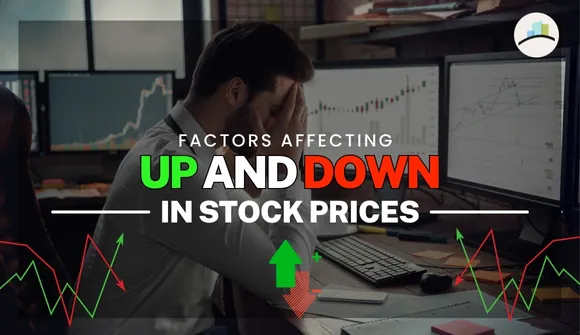Stock prices move every day. People gain/lose crores daily as the flickering green and red lights on the screen indicate continuous changes in the prices of these securities. However, have you ever thought “What causes these prices to move?”
One key term used frequently in the markets is Last Trading Price (LTP). LTP is the price at which a security was last transacted i.e. the price at which the security last changed hands. Let’s look at the concept with an example: -
Let’s say the price of ONGC was at Rs 250. This is the LTP i.e. shares of ONGC exchanged hands at the price of Rs 250 per share. Then, if the price suddenly drops to Rs 249 per share, it means that a buyer decided to exit his position at Rs 249 and a seller decided to enter the same.
The consistent buying and selling of securities at varying prices is what causes the prices of all financial securities to move up or down. This brings us to another question: “Why buy at a higher price / Why sell at a lower price?”
The financial markets have many participants. With over 1.1 crore buying/selling shares every month (NSE data), not everyone is of the same opinion. Some feel that a stock is undervalued at its current price while others may feel that it is overvalued. The interpretation of prices is dependent on individual understanding and independent calculations.
Therefore, it is not uncommon to sell a stock that is at its lifetime high as the owner feels the price has peaked while the buyer feels the stock could go higher! Thus, demand and supply are the most important factors when determining the price of any financial security.
A very famous example is Ketan Parekh, the protege of infamous investor Harshad Mehta. Ketan Parekh targeted shares with low liquidity and low market cap that belonged to growing industries and used illegally procured funds to drive up their prices. His pump and dump plan eventually fell apart and investors faced losses of over Rs 2,000 crores!!
Factors That Influence a Security’s Price in Details: -
-
Market trends
The overall market trend of the country that the stock belongs to is an important factor that contributes to price shifts. If let’s say the market of India is witnessing a Bull Run, the overall market sentiment is positive which would lead to buying pressure from both foreign and domestic participants.
Alternatively, if the country’s markets are down, then shares of the company in question will be dumped, not because the company is bad, but because investors are exiting their positions to avoid facing losses due to a Bear run.
A good stock will benefit from a positive market sentiment while it loses due to negative market sentiment. Thus, the overall market trend can be an important factor when determining the prices of a security.
-
News
Any listed company can actually affect the prices of its own stock! That’s right. Although directly influencing prices is illegal, business updates are not illegal. When companies announce corporate actions like buybacks, rights issues, or dividends, these are actions that are positive for investors, which ends up spiking share prices. Other business updates such as the acquisition of another rival or expansion plans also help boost share prices since it provides a positive outlook for the company.
The most common example of business updates is quarterly financial releases. Listed companies are required to publish their quarterly financials for investors to assess. If the company reports a good result, the future outlook for the company turns positive and investors end up buying into it for capital appreciation of their holdings.
However, news need not be positive every time. If the company reports poor quarterly results or if it announces the sale of important assets/businesses, investors end up selling to prevent any losses due to such negative developments.
Moreover, an interesting observation most people miss is that a company’s announcement can affect other shares or the entire industry as a whole! Let’s see the example of Grasim Industries. The company announced an investment of Rs 10,000 crores in May 2022 to foray into the decorative paints segment. Although this move was beneficial for Grasim, it sent other paint stocks like Asian Paints and Berger Paints down 5-10% due to increased competition!!
Furthermore, news need not be only from internal sources. News from external sources, verified or not, can also cause movement in the share prices of a company. The most famous example would be the malicious Hindenburg report on the Adani Group. The news that sent all Adani stocks and the Indian markets tumbling was a piece of external news that adversely affected the stock price of the Adani Group.
-
Government announcements
The government of a country is considered to be independent of the stock market. However, that is not true, the government has several important roles to play in the markets. They step in to protect investors, stabilize markets, regulate transactions, provide institutional frameworks, etc.
The government of a country can also influence its stock market and particular stocks by announcing policies or plans that are advantageous or disadvantageous for the economy as a whole or a particular sector.
Let’s consider two important examples: -
Firstly, when the Russia-Ukraine war began, oil prices began spiking as the Brent Crude spiked to a record $130/bbl! This meant that oil companies, without improving their business processes or operations, would be making record profits at the cost of innocent civilians. But investors were happy as oil stocks were surging.
Thus, to counter any adverse social impact, the Indian government announced the levy of a windfall tax on oil companies. This sent oil stocks tumbling as any excess profits were being taxed additionally.
Another example is the government’s push for ethanol blending. In May 2022, the Indian government announced a massive push for ethanol blending as it was moving to a 20% EBP. This meant greater demand for ethanol, which is a by-product of sugar, and thus sent sugar stocks soaring.
Other steps include the relaxation of policies and taxation, the introduction of production subsidies, or special schemes to boost any industry. These would positively affect every company’s stock which is part of that industry.
Conversely, higher taxation, banning exports to meet local demand, cancellation of subsidies, etc. are moves by the government that would negatively affect every company’s stock that is part of that industry.
-
Economic data
A country’s economic data also affects a share’s performance. A company could be performing at the top of its sector, but its share price would keep declining if investors lose faith in the economy of that country. Since the local demand, inflation levels, governmental policies, and other actions affect a company’s business as well, a growing economy ensures fundamental investor belief.
A common example of this is China. In January 2023, the Hang Seng was at its highest level in over 2 years as investors were excited about China coming out of its harsh COVID-19 lockdowns. However, poor consumer demand and a suffering real estate sector sent the entire index down.
Every share, irrespective of its sector, saw sharp declines throughout the year because foreign investors lost faith in the Chinese government’s ability to manage the economy and the overall outlook for the economy was grim.
Moreover, the economic conditions of other countries can also affect a different country’s market! When inflation in the US spiked to unbearable levels, the US Fed raised interest rates 3 times in less than 6 months!! Although the news related only to America, American firms began pulling out of major global markets, resulting in meltdowns in many economies!
Thus, the economic health of a country can determine the performance of a stock on the exchanges.
-
Manipulation
Lastly, the market can be moved due to deliberate manipulation. The practice of stock price manipulation is as old as time as all major markets witness some level of manipulation in prices.
The Indian markets are no exception as manipulation of stock prices happens to this day! Other than the occasional fraudster which the SEBI catches, the largest manipulator in the stock market is called an “Operator”.
As the name suggests, this is an entity that is large enough to ‘operate’ or influence the markets. Now an operator is either an institutional investor, a hedge fund, or a large group of traders working together to move prices where they want it to go. These entities have a large amount of capital which allows them to move markets wherever they want.
A common move operators tend to do is called the ‘Pump and Dump’ scheme. Here, the operators choose dead unknown stocks worth a negligible amount. Operators begin driving the prices up by bulk buying and show massive volume in these stocks to make it look like an attractive investment opportunity. Alongside this, they begin spreading positive news about the stock to make the pump look legit.
Once these operators realize that enough innocent investors have entered the stock, they dump their holdings, and investors are left with poor stocks with zero fundamentals!
A very famous example is Ketan Parekh, the protege of infamous investor Harshad Mehta. Ketan Parekh targeted shares with low liquidity and low market cap that belonged to growing industries and used illegally procured funds to drive up their prices. His pump and dump plan eventually fell apart and investors faced losses of over Rs 2,000 crores!!
FAQs :
1. What is the difference between market price and intrinsic value?
The market price is the current price at which a stock is trading in the market, determined by supply and demand. Intrinsic value, on the other hand, is an estimate of the true or inherent value of a stock based on its fundamentals, such as earnings, dividends, and growth prospects.
2. How can I track stock prices?
Stock prices can be tracked through financial news websites, stock market apps, brokerage platforms, and financial news channels. Ticker symbols are used to uniquely identify stocks, and real-time price quotes are available on these platforms.
3. Can stock prices go to zero?
Yes and No. Live traded stocks can never hit zero. They can be decimals i.e. less than a rupee, but never zero, because zero indicates valueless and that does not happen on an actively traded stock. However, stocks do end up as zero when they are delisted i.e. removed from the stock exchanges. Delisting normally happens due to bankruptcy.
4. How does the trading volume affect stock prices?
Trading volume represents the total number of shares traded during a specific period. Higher trading volume can indicate increased investor interest and can sometimes precede significant price movements. However, it's essential to consider other factors along with volume.











 1,499
1,499
